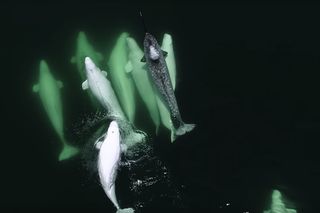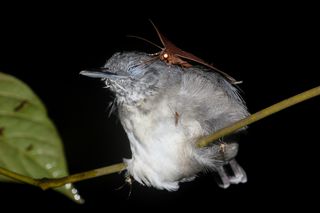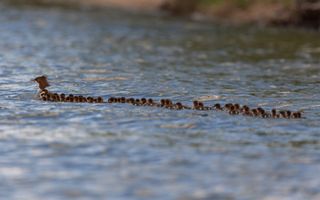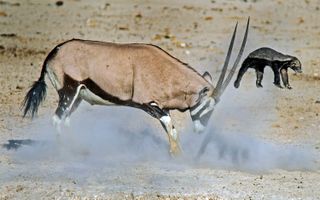10 Times Animals Behaved Oddly in 2018
Oddball animals of 2018

Scientists have been studying the animal kingdom for hundreds of years, and while many mysteries remain, it's pretty clear that animal behavior is consistently inconsistent, and occasionally, just plain weird. From a sexually frustrated dolphin to a duck with 76 ducklings in tow, here are some of the most oddly behaving animals of 2018.
Hypnotic spiral hive

This year started off with a popular photo posted on Reddit showing the amazing spiral-shaped hive of the Australian stingless bee, Tetragonula carbonaria. The symmetrical, spiral tower is called the brood comb and is made up of hundreds of individual egg chambers linked together in a continuous staircase of unborn baby bees.
Why T. carbonaria build their brood combs in this perfect spiral shape is a mystery; maybe it's random, or maybe it's an adaptive behavior. There are advantages to the shape, as it's an efficient use of space and facilitates air circulation among the layers, said Tim Heard, the entomologist in Australia who took the photo. But Heard also pointed out that if the spiral shape is adaptive, he'd expect it to be more common. [Read more about the mysterious spiral bee hive.]
Polite (and adorable) friends

Also at the beginning of 2018, we were charmed by an unlikely but adorable pair of animal friends — a dog and a lion — that appear to very politely shake hands. In a video shared on Instagram, the large white lion saunters up to the tail-wagging dog, scoops the canine's right paw and cups it briefly, then nudges the much smaller beast's foot with its muzzle before releasing the paw.
In the wild, a chance encounter between a dog and a full-grown lion likely wouldn't be this cordial. But this odd couple grew up together, and they're now in the care of the Black Jaguar-White Tiger Foundation, a nonprofit based in Mexico that houses large cats and other wildlife.
While a friendship between a dog and a lion is pretty unusual, it's not unheard of for animals in captivity to form close bonds with species that they would otherwise avoid (or eat) simply because they enjoy each other's company. For example, a bear, lion and tiger rescued from a private collection when they were only a few months old are now closely bonded as adults in a reserve near Atlanta, and a leopard that was rescued as a cub in South Africa is best buds with a golden retriever. [Read more about these polite friends]
A well-received outcast

This year, we saw another odd friendship, when a young, orphaned male narwhal was spotted with a gang of 10 male beluga whales in eastern Canada, about 620 miles (1,000 kilometers) south of the Arctic habitat where narwhals are typically found. This was the third year the gray, speckled narwhal had been spotted hanging out with his snow-white beluga bros.
Researchers at the Group for Research and Education on Marine Mammals (GREMM) said the young narwhal likely swam south after his Arctic habitat lost too much ground to climate-related ice melt. Fortunately for the outcast narwhal, the belugas seem to have accepted it as one of the boys. [Read more about narwhal adopted by beluga whales]
Playing with food

In a not-so-friendly move, a small pod of orcas near the Galápagos Islands were caught on camera this summer as they treated a couple of helpless sea turtles like underwater Frisbees.
The orcas playfully pushed, spun and dragged the poor sea turtles around the water, appearing to be very entertained by their live reptile toys. Orcas are known to play with their food before eating, but this was likely the first time they've been filmed tormenting sea turtles. It's unclear if these orcas eventually ate the turtles or just left them to recover from their dizzying adventure. [Watch the video of beautiful orcas toying with helpless sea turtles]
A lucky moth

In a totally metal move, one seriously bold moth landed on a sleeping bird's head and dared to gingerly sip the bird's tears. The rare event was caught on camera by Leandro João Carneiro de Lima Moraes, a biologist at the National Institute of Amazonian Research in Brazil.
Tear-drinking in the animal kingdom isn't that unusual, as it's a great way for insects like butterflies, moths and bees to supplement their diets. Typically, the tear-drinkers will take advantage of cold-blooded reptiles like crocodiles or turtles, which are prone to going torpid, or lowering their metabolism and lying still for extended periods of time, making them an easy target.
Birds, on the other hand, are a little harder to pin down; they're small, fast and really good at flying. This particular moth probably got lucky, Moraes wrote. The moth landed on the bird at night, when the black-chinned antbird enters a torpid state, becoming virtually immobile as a side effect of lowering its body temperature. [Watch the fearless moth drink a bird's tears]
Amazing mamma duck

One supermom duck was seen leading around a remarkable brood of 76 adorable ducklings this summer. Nature photographer Brent Cizek captured shots of the amazing "Mamma Merganser" at Lake Bemidji in northeastern Minnesota in late June. The mamma duck and her tiny followers are all common mergansers, the Mergus merganser species.
Cizek said he counted at least 50 little quackers in the photo, but on subsequent visits, he saw as many as 76 chicks lined up neatly behind their matriarch. While it's not unusual to see a couple dozen ducklings following a single mother, a group of 50 or more is rather astonishing.
According to experts, all those ducklings were definitely not from the same mother. Some of them might belong to this mamma duck, but the rest of these tiny birds were probably participating in a duckling day care system, called a crèche. Adult female birds will entrust their young to an older, wiser female that is usually more experienced in raising wee ones and doesn't mind taking a few more ducklings under her wing. [Read more about the incredible "Mamma Merganser"]
Stuck in a bad spot

What looks like the fattest string of snot hanging from this seal's nose is really a very unfortunate eel. In a photo from the Hawaiian Monk Seal Research Program, a poor Hawaiian monk seal is seen squinting in a look of irritation as a probably very distressed eel lies stuck up the mammal's nostril.
It's rare for eels to get stuck up seals' noses, but not unheard of. The program's researchers have observed only three or four cases of eel-up-seal-nose in the past four decades. What's odd is that the incidents have all occurred within the past few years. The researchers said they suspect the eel was trying to escape being a seal snack and just picked the wrong hole to hide in. [Read more about seal with an eel stuck in its nostril]
An uneven battle

Honey badgers are notoriously fearless, but it was still surprising to see one take on a South African oryx — a type of horned antelope 10 times the honey badger's size.
Dick Theron was visiting Etosha National Park in South Africa when he spotted the lopsided battle taking place and captured some incredible images. Theron told the Daily Mail that the badger approached the antelope at a watering hole and started the fight.
"It kept on charging at the oryx. Then, the oryx would hook the badger between its horns and toss him 5 or 6 meters [16 to 19 feet] into the air," Theron said. The honey badger "just got up, shook itself and then charged at the oryx again!"
We may never know why this honey badger picked a fight it was sure to lose, but it's clear this ferocious fighter lives up to its species' fearsome reputation. [See more photos of the uneven fight]
The daredevil raccoon

Of course, we cannot forget about the famous daredevil racoon that captivated onlookers earlier this year as it slowly climbed the vertical concrete wall of a skyscraper in Minnesota. The small, masked acrobat took breaks at various window ledges, which resulted in some amazing photos and rising anxiety as viewers around the world wondered if the racoon would keep climbing or plunge to a tragic end.
But the expert climber kept going up, and after about 20 hours, reached the roof of the 23-story building, where it was safely captured and returned to the ground.
No one knows why the urban critter scaled the side of a skyscraper; it may have been startled and found the first thing it could climb to get away, said Bryan Lueth, a Minnesota Department of Natural Resources employee. With their sharp, nonretractable claws at the ends of their long fingers and toes, racoons are excellent climbers. This adorable trash panda was just doing what it does best. [Read more about the high climbing racoon]
A sexually frustrated dolphin

Rounding out this list of odd animal behavior is Zafar, the sexually frustrated dolphin. Zafar was a bottlenose dolphin who was just looking for love in all the wrong places — specifically, the Bay of Brest in western France.
This summer, the 10-foot-long (3 m) dolphin developed a habit of rubbing up against both people and boats, signaling his desire for, well, sex. He lifted one woman in the air with his nose, and in another case, he refused to let a swimmer return to shore. Zafar's behavior got so bad that authorities were forced to shut down the beach whenever the frisky dolphin came around.
Dolphins are known to have recreational sex and will occasionally direct their sexual energy toward other species, but humans aren't a common target. However, in the 1960s, a dolphin named Peter reportedly lusted after one of his female trainers. The dolphin was said to have died of a broken heart after he was moved to another facility. [Read more about Zafar, the lustful dolphin]
Sign up for the Live Science daily newsletter now
Get the world’s most fascinating discoveries delivered straight to your inbox.

Kimberly has a bachelor's degree in marine biology from Texas A&M University, a master's degree in biology from Southeastern Louisiana University and a graduate certificate in science communication from the University of California, Santa Cruz. She is a former reference editor for Live Science and Space.com. Her work has appeared in Inside Science, News from Science, the San Jose Mercury and others. Her favorite stories include those about animals and obscurities. A Texas native, Kim now lives in a California redwood forest.
